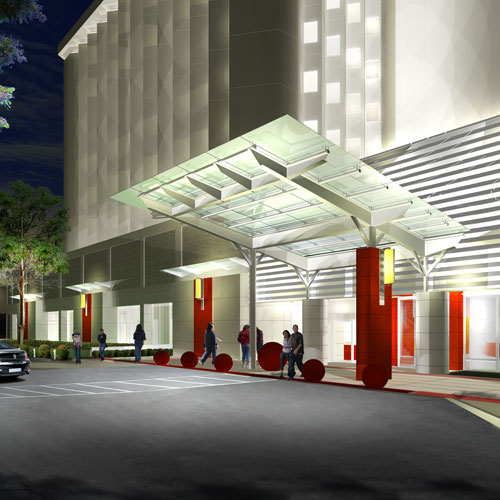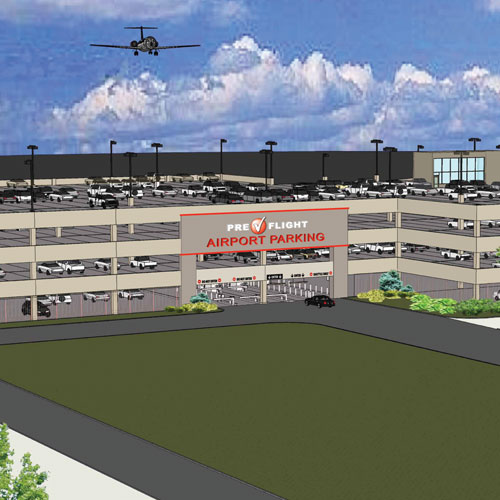New Orleans has had a rough decade. First Hurricane Katrina in 2005, then Hurricane Rita just a few weeks later, and only five years after that, in the middle of the city’s recovery, the Deepwater Horizon oil spill inundated the Louisiana coastline with millions of barrels of crude.
Despite all this, though, there have been gains, including ongoing upgrades to the National World War II Museum that began in 2011 and the hosting of the Super Bowl at the restored Metrodome in 2013. It’s a historically important city with remarkable resilience, and for these reasons, Iftikhar Ahmad sees it as a national treasure. He’s the aviation director for the Louis Armstrong New Orleans International Airport, which has itself suffered as of late, and he’s more than a little eager to get started on a massive new project: the North Terminal Complex. The project will allow the airport to better represent—from physical, logistical, and financial perspectives alike—the gem of a city that it serves.

First and foremost, the revitalization of the airport will play a key role in New Orleans’s continued recovery by bringing in new business, and Ahmad knows and can point to case studies that back this idea up. There’s NCR Corporation, a company that traded its century-old Dayton, Ohio, roots for Atlanta when flights in and out of Dayton became too limited. There’s also Chiquita Brand International, a business once based in Cincinnati that lit out for greener pastures and found them in Charlotte, North Carolina, home to a growing airport. “Airports are playing a significant role in economic development,” Ahmad says. “And we want to ensure we do the best we can to encourage economic growth here in this state and this region.”
Plus, on a more basic level, an upgrade to New Orleans’s airport is just plain necessary. The facility’s existing main terminal is more than 50 years old, and its maintenance and operating costs are high. Most of the airport’s concessions are located outside the secured area, reducing their revenue sharply. Interstate access to the airport is difficult. The lack of automation during baggage screening slows baggage handling to one-sixth the rate it would be otherwise. The airport’s security checkpoints are anything but consolidated, and once passengers are screened, multiconcourse access is restricted.
“So, when we have a convention that comes [into town] with 20,000 people, and the convention breaks a certain day, all 20,000 folks charge to the airport,” Ahmad says. “And [at the same time] there’s a sale going on with a particular airline’s airfares, so everybody shows up at that concourse and floods that checkpoint. So, there are delays, and the conventioneers are not happy. We needed to fix that.”

The long-awaited solution was unveiled by New Orleans Mayor Mitch Landrieu at a January 2014 press conference: it’s an all-new, 30-gate, North Terminal Complex, designed by a team that includes star Argentinian architect César Pelli, to be completed in time for the city’s 300th anniversary in May 2018. With funding coming from FAA AIP grants, TSA grants, State Aviation Trust Fund grants, Passenger Facility Charges, and more, the $650 million terminal will come at no cost to the City of New Orleans itself, and it will create 13,000 jobs. Additionally, the airport will generate more income from nonairline revenue streams (e.g. concessions), and its per-passenger profit is expected to be nearly 20 times better than it is currently. “When there’s a need for services created, a need for jobs is created, which enhances quality of life here,” Ahmad says.
The North Terminal project comes after years of starts and stops regarding how to improve New Orleans’s airport. Ahmad, who began working there just a couple of weeks after Landrieu took over as mayor in 2010, concurs that there was “a lot of confusion for a long time” as everything from relocating the airport to privatizing it was considered then abandoned. “Prior to 2010 and during that confusion, the airport basically got dilapidated,” he says. “So, in 2010, as a community, we decided: one, we would not sell the airport because it was not in the best public interest, and, two, we would not relocate the airport.”
What they did do, while discussing the airport’s long-term future, was give it a makeover: workers refurbished dozens of concessions as part of a $30–40 million interior aesthetic upgrade (including furniture, lighting, etc.), and they repaired and enhanced exterior pavements, runways, and airfields. “It is work that should have been done many years ago,” Ahmad says of the changes, which were completed in time for the 2013 Super Bowl.

The North Terminal project, on the other hand, is far from a simple facelift. Among other things, it will expand the airport by 645,440 square feet, and it will include a 2,000-space parking garage, additional security checkpoints to improve foot traffic, in-line AVA systems to speed up baggage checks, a $72 million sustainable central power plant, 12 miles of extra lanes on circulation roads, 42 more acres of airfield termination apron, and a host of third-party projects such as new hotels and a new I-10 interchange.
Just as important as all that, though, Ahmad says, is the “sense of place” that will be created by the new design. It’ll be a multisensory experience integrating colors, food/concessions (which will be located in the center of each concourse rather than at the sides), and live music. “We will convey the message of this community and all its traditions, tastes, and cultures when you go through this new terminal,” Ahmad says.
Building without disrupting passenger flow and phasing the project will both be nonissues because security clearances require the North Terminal to be completed “at once,” and it will be constructed on what is currently empty green space north of the airport’s main runway. Crews will use fencing to keep the structure outside the secured area of the airport. “When the building opens, we’ll move our fences back to the side of the terminal to make sure the airfield will be inside the security,” Ahmad says.
Eighty percent of all of Louisiana’s air passengers come in via the Louis Armstrong New Orleans International Airport, so upgrades to the facility will only increase tourism in the city and the state as they continue to rebuild rapidly. “[The North Terminal Complex] personifies all that success,” Ahmad says. “[And it’s] important to keep up with the schedule so [that] we can deliver this one part of the many, many parts of the goodness that is happening in the place we call New Orleans. There’s a return in it for our airlines but also a return for our community, our state, and our region.”


